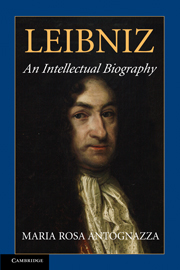Introduction
Published online by Cambridge University Press: 05 September 2014
Summary
On 13 november 1717, the secretary of th Académie Royale des Sciences, Bernard Le Bovier de Fontenelle, presented to his colleagues in Paris a eulogy of Gottfried Wilhelm Leibniz, who had died a year and a day earlier. Fontenelle had corresponded with the German philosopher on numerous occasions, and his “Éloge” could also draw on the biographical sketch provided by Leibniz's secretary, Johann Georg Eckhart. Informed by such personal knowledge, the French savant naturally identified at the outset the aspect of his subject most worthy of a eulogy: the extraordinary range of Leibniz's intellectual achievements. “In somewhat the same way that ancients could manage simultaneously up to eight harnessed horses,” he observed in the classicising vein still fashionable even in scientific circles in Paris, “Leibniz could manage simultaneously all the sciences.” Yet this very intellectual range confronted Fontenelle with seemingly insuperable difficulties in composing an intelligible biographical sketch. Leibniz, he lamented, “wrote about different matters during the same years, and … this almost perpetual jumble, which did not produce any confusion in his ideas, these abrupt and frequent transitions from one subject to another completely opposite subject, which did not trouble him, would trouble and confuse this history.” Confronted by the difficulty of keeping eight rampant lines of intertwining intellectual development from getting hopelessly tangled with one another, Fontenelle abandoned “the customary chronological order” and organised his eulogy thematically.
- Type
- Chapter
- Information
- LeibnizAn Intellectual Biography, pp. 1 - 14Publisher: Cambridge University PressPrint publication year: 2008

